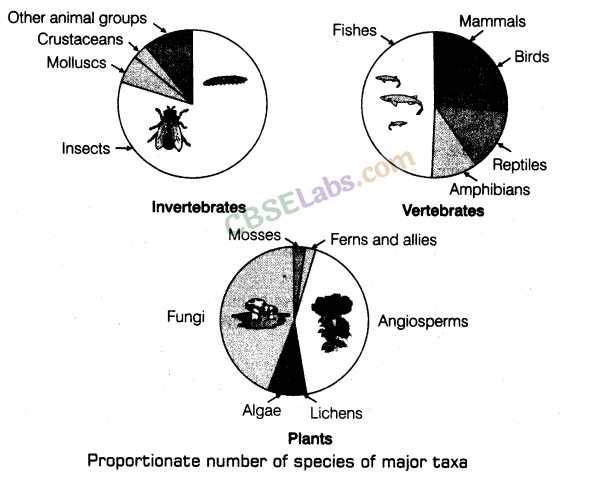Biodiversity and Conservation – CBSE Notes for Class 12 Biology
CBSE Notes CBSE Notes Biology NCERT Solutions Biology
Biodiversity:
1. Biodiversity
can be defined as the occurrence of different types of genes, gene pools, species, habitats and ecosystem in a given region.
(i) The term biodiversity was given by a socio biologist Edward Wilson to describe the combined diversity at all the levels of biological organisation.
(ii) There are more than 20,000 species of ants, 3,00,000 species of beetles, 28,000 species of fishes and nearly 20,000 species of orchids.
(iii) Biodiversity can be divided into following three levels:
(a) Genetic diversity is the diversity at the genetic level.
• It enables a population to adapt to its environment.
• India has more than 50,000 genetically different strains of rice and 1,000 varieties of mango.
Example, Genetic variation in the medicinal plant Rauwolfia vomitoria growing in different Himalayan ranges might be in terms of the potency and concentration of the active chemical (reserpine) that the plant produces.
(b) Species diversity is diversity at the species level. For example, the Western Ghats have a greater amphibian species diversity than the Eastern Ghats.
(c) Ecological diversity is the diversity at ecosystem level. For example, India with its deserts, rain forests, mangroves, coral reefs, wetlands, estuaries and alpine meadows has a greater ecosystem diversity.
2. Global species diversity
means total species present on the earth.
(i) According to IUCN (2004) the total number of plant and animal species is slightly more than 1.5 million.
(ii) For many taxonomic groups, species inventories are more complete in temperate than in tropical countries.
(iii) A more conservative and scientifically sound estimate by Robert May, places the global species diversity at about 7 million.
(iv) More than 70% of all the species recorded are animals, while plants comprise no more than 22% of the total.
(v) Among animals, insects are most species rich-taxonomic group, making about 70% of the total. It means, out of every 10 animals, 7 are insects on the earth.
3. Biodiversity in India
(i) Although India has only 2.4% of the world’s land area, its share of the global species diversity is 8.1%. This makes India one of the 12 megadiversity countries of the world.
(ii) About 45,000 species of plants and twice as many of animals have been recorded from India.

(iii) According to May’s global estimates, only 22% of the total species have been recorded so far. If this proportion.is applied to India’s diversity figures, there may be probably more than 1,00,000 plant species and more than 3,00,000 animal species yet to be discovered and described.
4. Patterns of biodiversity indicate that the biodiversity is not uniform throughout the world because it is affected by:
(i) Latitudinal gradients demonstrates the decrease in species diversity as we move away from the equator towards the poles.
(a) Tropics (latitudinal range of 23.5°N to 23.5°S) harbour more species than temperate or polar areas.
(b) Example, Colombia located near the equator has around 1,400 species of birds, while New York at 41°N has 105 species and greenland at 71°N has only 56 species.
(c) Studies indicate that the tropical areas have more biodiversity.
For example,
• India with much of its land area in the tropical latitudes, has more than 1,200 species of birds.
• A tropical forest in equator has up to 10 times as many species of vascular plants as a forest of equal area in a temperate region like the midwest of USA.
• Tropical Amazonian rainforest in South America has the greatest biodiversity on earth. It homes 40,000 species of plants, 3,000 of fishes, 1,300 of birds, 427 of mammals, 427 of amphibians, 378 of reptiles and of more than 1,25,000 invertebrates.
• Scientists estimate that in these rainforests, there might be at least 2 million insect species waiting to be discovered and named.
(d) Reasons for Greater Biodiversity in Tropics
• Speciation is generally a function of time. The temperate regions were subjected to frequent glaciation in the past, but the tropics have remained undisturbed and hence, had evolved more species diversity.
• Tropical environments, unlike temperates are less seasonal, relatively more constant and predictable. Such constant environments promote niche specialisation and lead to a greater species diversity.
• More solar energy is available in tropics, which contributes to higher productivity, this in turn might contribute indirectly to greater diversity.
(ii) Species-Area Relationships
(a) Alexander Von Humboldt, a German naturalist and geographer observed that within a region, species richness increased with increasing explored area, but up to a limit.
(b) In fact, the relation between species richness and area for a wide variety of taxa (like angiosperm plants, birds, bats and freshwater fishes) turn out to be rectangular hyperbola.

(c) On a logarithmic scale, the relationship is a straight line as given in the following equation
log S = log C + Z log A where, S = Species richness, A=Area
C = Y-intercept, Z = Slope of the line (regression coefficient)
(d) The value of Z lies in the range of 0.1-0.2 regardless of taxonomic group or the region.
(e) If we analyse the species-area relationship among very large areas like the entire continents, the slope of the line will be much steeper, i.e. Z values in the range of 0.6-1.2. For example, for fruit eating birds and mammals in the tropical forests of different continents, the slope is found to be 1.15.
5. Importance of Species Diversity to the Ecosystem
(i) According to ecologists, communities with more species tend to be more stable than those with less species.
(ii) Attributes of a stable community are
(a) It should not show too much variation in productivity from year to year.
(b) It must be either resistant or resilient to occasional disturbances (natural or man made).
(c) It must be resistant to invasions by alien species.
(iii) David Tilman’s longterm experiments on ecosystem found that plots with more species showed less year-to-year variation in total biomass. He also showed that increased diversity contributed to higher productivity.
(iv) It is not clear how species richness contributes to the well-being of an ecosystem. But, it is enough to realise that rich biodiversity is not only essential for ecosystem health but imperative for the survival of the human race on this planet.
(v) Paul Ehrlich through his rivet popper hypothesis tried to explain the importance of biodiversity for the survival of species.
(a) The hypothesis assumes the ecosystem to be an airplane and the species to be the rivets joining all parts together.
(b) If every passenger pops a rivet to take home (resulting in species extinction), it may not affect the flight safety initially (proper ecosystem functioning) but with time as more and more rivets are removed, the plane becomes dangerously weak.
(c) Loss of rivet on the wings (key species that drives major ecosystem functions) is a more serious threat to flight safety than loss of a few rivets on the seats or windows of the plane.
6. Loss of biodiversity
is caused by the over population, urbanisation and industrialisation.
(i) The colonisation of tropical Pacific Islands by humans have led to the extinction of more than 2,000 species of native birds.
(ii) The IUCN Red list (2004) documents the extinction of 784 species (including 338 vertebrates, 359 invertebrates and 87 plants) in the last 500 years.
(iii) Some latest examples of recent extinctions are dodo (Mauritius), Quagga (Africa), Thylacine (Australia), Steller’s sea cow (Russia) and three sub-species (Bali, Javan and Caspian) of tiger.
(iv) The last twenty years alone have witnessed the disappearance of 27 species.
(v) Presently, 12% of bird species, 23% of all mammal species, 32% of all amphibian species and 31% of all gymnosperm species in the world face the threat of extinction.
(vi) Careful analysis of records shows that amphibians appear to be more vulnerable to extinction.
(vii) The grim scenario of extinctions is the fact that more than 15,500 species world wide are facing the threat of extinction.
Results of Loss of Biodiversity in a Region
(a) Decline in plant production.
(b) Lowered resistance to environmental perturbations, such as drought.
(c) Increased variability in certain ecosystem processes such as plant productivity, water use, pest and disease cycles.
Causes of Biodiversity Losses
These are mainly four as given below. They are also named as The Evil Quartet.
(i) Habitat Loss and Fragmentation
(a) The main cause of extinction of species is the destruction of their habitat
(b) Examples,
• Tropical rainforests once covering more than 14% of the land surface, now cover only 6% of land area.
• Amazon rainforest (called lungs of the planet) is being cut and cleared for the cultivation of soybeans and for conversion to grasslands for raising beef cattle.
(c) When large habitats are broken up into small fragments due to various human activities, mammals and birds requiring large territories and certain animals with migratory habits are badly affected, leading to their population decline.
(d) The degradation of many habitats by pollution also threatens the survival of many species, many have extincted in last 500 years.
(ii) Over-exploitation of natural resources by humans results in degradation and extinction of the resources. For example, Steller’s sea cow, passenger pigeon and many marine fishes have extincted in last 500 years.
(iii) Alien (exotic) Species Invasions
When alien (exotic) species are introduced unintentionally or deliberately, some become invasive and cause harmful impact resulting in extinction of the indigenous species. Examples,
(a) Nile perch a large predator fish when introduced in Lake Victoria (East Africa) caused the extinction of an ecologically unique species of cichlid fish in the lake.
(b) Invasive weed species like Parthenium (carrot grass), Lantana and Eichhornia (water hyacinth) caused environmental damage and pose threat to native species.
(c) The recent example is of the African cat fish (Clarias gariepinus) introduced for aquaculture purpose, is posing a threat to the indigenous cat fishes of Indian rivers.
(iv) Co-extinctions When a species become extinct, the plant and animal species associated with it in an obligatory manner, also become extinct. For example, if the host species becomes extinct, all those parasites exclusively found on it will also become extinct. In plant pollinator mutualism, extinction of one results in the extinction of the other.
NCERT Solutions Maths Physics Chemistry Biology Science